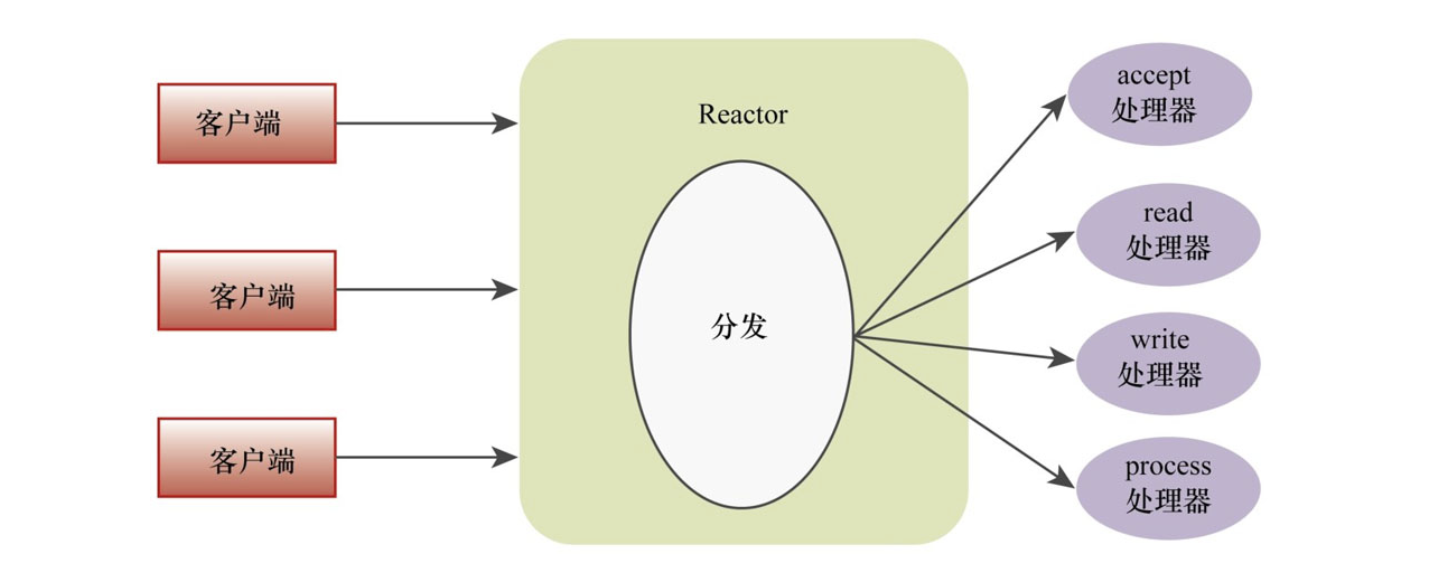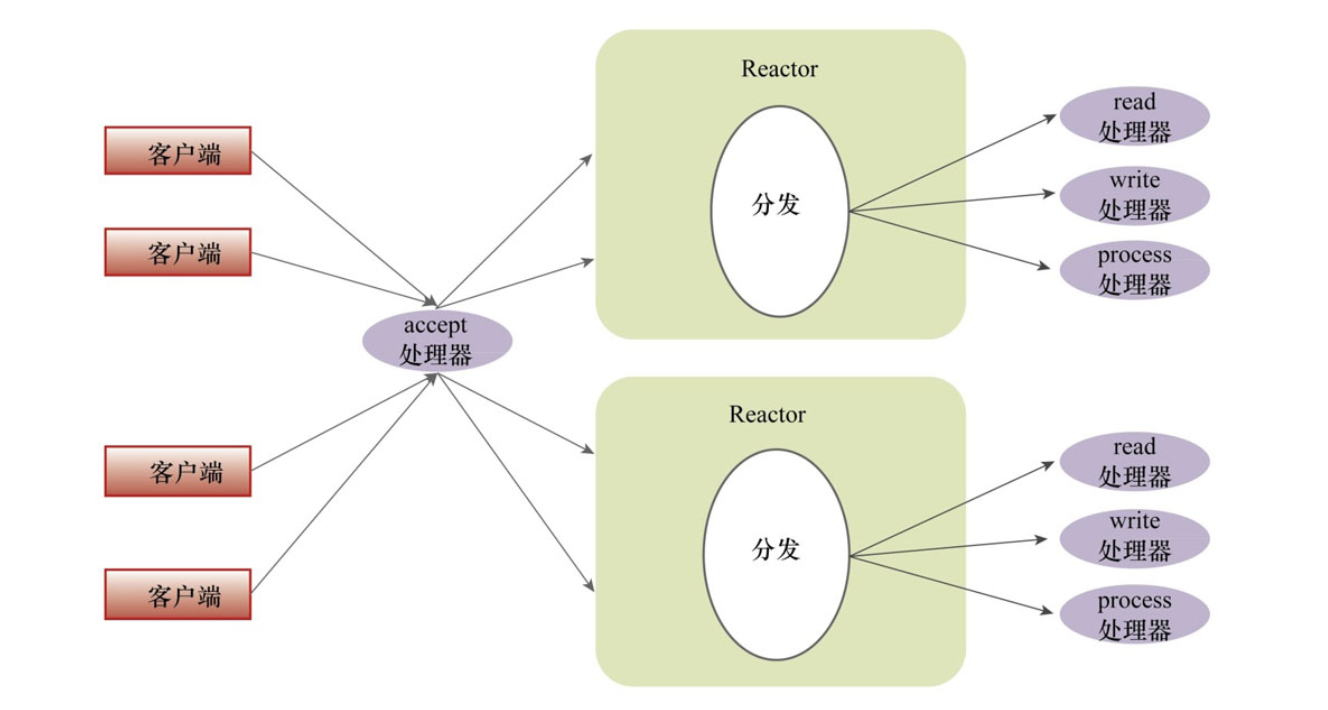本文内容主要转载于也谈Reactor模式,点击可以查看原文。
什么是Reactor模式
反应器设计模式(Reactor pattern)是一种为处理并发服务请求,并将请求提交到一个或者多个服务处理程序的事件设计模式。当客户端请求抵达后,服务处理程序使用多路分配策略,由一个非阻塞的线程来接收所有的请求,然后派发这些请求至相关的工作线程进行处理。
对于高并发系统,常会使用Reactor模式,其代替了常用的多线程处理方式,节省系统的资源,提高系统的吞吐量(并不能提升响应速度)。像我们平时常用的Tomcat服务器和Netty框架中都有Reactor模式的实现。
这边博客就来介绍下Reactor模式这个抽象的概念。
从BIO模式到Reactor模式
BIO模式
Java1.4(2002年)以前,IO都是Blocking的,也就是常说的BIO,它在等待请求、读、写(返回)三个环节都是阻塞的。在等待请求阶段,系统无法知道请求何时到达,因此需要一个主线程一直守着,当有请求进来时,将请求分发给读写线程。如图:

代码如下:
ExecutorService executor = Excutors.newFixedThreadPollExecutor(100);//线程池
ServerSocket serverSocket = new ServerSocket();
serverSocket.bind(8088);
while(!Thread.currentThread.isInturrupted()){//主线程死循环等待新连接到来
Socket socket = serverSocket.accept();
executor.submit(new ConnectIOnHandler(socket));//为新的连接创建新的线程
}
class ConnectIOnHandler extends Thread{
private Socket socket;
public ConnectIOnHandler(Socket socket){ this.socket = socket; }
public void run(){
while(!Thread.currentThread.isInturrupted()&&!socket.isClosed()){//死循环处理读写事件
String someThing = socket.read()....//读取数据
if(someThing!=null){
......//处理数据
socket.write()....//写数据
}
}
}
需知,请求进来(accept),并不表示数据马上达到了,可能隔一段时间才会传进来,这个时候socket.read()也是一直阻塞的状态。socket.write()也同理,当向磁盘或其它socket写数据时,也要等对方准备好才能写入,在对方准备阶段,socket.write()也是阻塞的。这两个环节可能的无效阻塞导致读写线程的低效。
NIO模式
Java1.4开始,引入了NIO。NIO有三个概念:Selector、Buffer、Channel。与BIO的区别是,请求进来后,并不会马上分派IO线程,而是依靠操作系统底层的多路复用机制(select/poll/epoll等),在监听到socket读写就绪之后,再分配IO线程(实际可由当前线程[使用Buffer和Channel]直接读写,因为读写本身的效率很高),这就避免了线程等待。且与BIO多线程方式相比,使用I/O多路复用技术,系统不必创建和维护庞大的线程池,从而大大减小了开销。这部分工作是NIO的核心,由Selector负责,本质上是多路复用的Java封装。而Buffer和Channel又封装了一层socket的读写,应该为的是将IO与业务代码彻底分离。以下图示为本人理解:

如图示,与BIO中监听线程职责不同,Selector监听的不只是连接请求,还有读写就绪事件,当某个事件发生时,即通知注册了该事件的Channel,由Channel操作socket读写Buffer。虚线表示需要具体的NIO框架或业务代码自己处理,比如Channel如何注册以及注册何种事件,Channel处理IO的方式(如在当前线程处理还是新开线程,若新开线程,则可看作是AIO模式)等。NIO只是提供了一套机制,具体使用还是需要编程实现(Reactor模式就是OO的一种实现)。
示例代码(摘自Java NIO详解)
服务端:
package cn.blog.test.NioTest;
import java.io.IOException;
import java.net.InetSocketAddress;
import java.nio.ByteBuffer;
import java.nio.channels.*;
import java.nio.charset.Charset;
import java.util.Iterator;
import java.util.Set;
public class MyNioServer {
private Selector selector; //创建一个选择器
private final static int port = 8686;
private final static int BUF_SIZE = 10240;
private void initServer() throws IOException {
//创建通道管理器对象selector
this.selector=Selector.open();
//创建一个通道对象channel
ServerSocketChannel channel = ServerSocketChannel.open();
channel.configureBlocking(false); //将通道设置为非阻塞
channel.socket().bind(new InetSocketAddress(port)); //将通道绑定在8686端口
//将上述的通道管理器和通道绑定,并为该通道注册OP_ACCEPT事件
//注册事件后,当该事件到达时,selector.select()会返回(一个key),如果该事件没到达selector.select()会一直阻塞
SelectionKey selectionKey = channel.register(selector,SelectionKey.OP_ACCEPT);
while (true){ //轮询
selector.select(); //这是一个阻塞方法,一直等待直到有数据可读,返回值是key的数量(可以有多个)
Set keys = selector.selectedKeys(); //如果channel有数据了,将生成的key访入keys集合中
Iterator iterator = keys.iterator(); //得到这个keys集合的迭代器
while (iterator.hasNext()){ //使用迭代器遍历集合
SelectionKey key = (SelectionKey) iterator.next(); //得到集合中的一个key实例
iterator.remove(); //拿到当前key实例之后记得在迭代器中将这个元素删除,非常重要,否则会出错
if (key.isAcceptable()){ //判断当前key所代表的channel是否在Acceptable状态,如果是就进行接收
doAccept(key);
}else if (key.isReadable()){
doRead(key);
}else if (key.isWritable() && key.isValid()){
doWrite(key);
}else if (key.isConnectable()){
System.out.println("连接成功!");
}
}
}
}
public void doAccept(SelectionKey key) throws IOException {
ServerSocketChannel serverChannel = (ServerSocketChannel) key.channel();
System.out.println("ServerSocketChannel正在循环监听");
SocketChannel clientChannel = serverChannel.accept();
clientChannel.configureBlocking(false);
clientChannel.register(key.selector(),SelectionKey.OP_READ);
}
public void doRead(SelectionKey key) throws IOException {
SocketChannel clientChannel = (SocketChannel) key.channel();
ByteBuffer byteBuffer = ByteBuffer.allocate(BUF_SIZE);
long bytesRead = clientChannel.read(byteBuffer);
while (bytesRead>0){
byteBuffer.flip();
byte[] data = byteBuffer.array();
String info = new String(data).trim();
System.out.println("从客户端发送过来的消息是:"+info);
byteBuffer.clear();
bytesRead = clientChannel.read(byteBuffer);
}
if (bytesRead==-1){
clientChannel.close();
}
}
public void doWrite(SelectionKey key) throws IOException {
ByteBuffer byteBuffer = ByteBuffer.allocate(BUF_SIZE);
byteBuffer.flip();
SocketChannel clientChannel = (SocketChannel) key.channel();
while (byteBuffer.hasRemaining()){
clientChannel.write(byteBuffer);
}
byteBuffer.compact();
}
public static void main(String[] args) throws IOException {
MyNioServer myNioServer = new MyNioServer();
myNioServer.initServer();
}
}
客户端:
package cn.blog.test.NioTest;
import java.io.IOException;
import java.net.InetSocketAddress;
import java.nio.ByteBuffer;
import java.nio.channels.SelectionKey;
import java.nio.channels.Selector;
import java.nio.channels.SocketChannel;
import java.util.Iterator;
public class MyNioClient {
private Selector selector; //创建一个选择器
private final static int port = 8686;
private final static int BUF_SIZE = 10240;
private static ByteBuffer byteBuffer = ByteBuffer.allocate(BUF_SIZE);
private void initClient() throws IOException {
this.selector = Selector.open();
SocketChannel clientChannel = SocketChannel.open();
clientChannel.configureBlocking(false);
clientChannel.connect(new InetSocketAddress(port));
clientChannel.register(selector, SelectionKey.OP_CONNECT);
while (true){
selector.select();
Iterator<SelectionKey> iterator = selector.selectedKeys().iterator();
while (iterator.hasNext()){
SelectionKey key = iterator.next();
iterator.remove();
if (key.isConnectable()){
doConnect(key);
}else if (key.isReadable()){
doRead(key);
}
}
}
}
public void doConnect(SelectionKey key) throws IOException {
SocketChannel clientChannel = (SocketChannel) key.channel();
if (clientChannel.isConnectionPending()){
clientChannel.finishConnect();
}
clientChannel.configureBlocking(false);
String info = "服务端你好!!";
byteBuffer.clear();
byteBuffer.put(info.getBytes("UTF-8"));
byteBuffer.flip();
clientChannel.write(byteBuffer);
//clientChannel.register(key.selector(),SelectionKey.OP_READ);
clientChannel.close();
}
public void doRead(SelectionKey key) throws IOException {
SocketChannel clientChannel = (SocketChannel) key.channel();
clientChannel.read(byteBuffer);
byte[] data = byteBuffer.array();
String msg = new String(data).trim();
System.out.println("服务端发送消息:"+msg);
clientChannel.close();
key.selector().close();
}
public static void main(String[] args) throws IOException {
MyNioClient myNioClient = new MyNioClient();
myNioClient.initClient();
}
}
在早期的JDK1.4和1.5 update10版本之前,Selector基于select/poll模型实现,是基于IO复用技术的非阻塞IO,不是异步IO。在JDK1.5 update10和linux core2.6以上版本,sun优化了Selctor的实现,底层使用epoll替换了select/poll。另据说Buffer指向的并非堆内内存,NIO使用 Native 函数库直接分配堆外内存,然后通过一个存储在 Java 堆的 DirectByteBuffer 对象作为这块内存的引用进行操作,避免了在 Java 堆和 Native 堆中来回复制数据。
NIO的实现解析可参看:深入浅出NIO Socket实现机制
Reactor模式
NIO为实现Reactor模式提供了基础,上面的NIO图示其实就是Reactor模式的雏形,只是Reactor以OO的方式抽象出了几个概念,使得职责划分更加明确。
Reactor将服务器端的整个处理过程分成若干个事件,例如分为接收事件、读事件、写事件、执行事件等。Reactor通过事件检测机制将这些事件分发给不同处理器去处理。若干客户端连接访问服务器端,Reactor负责检测各种事件并分发到处理器,这些处理器包括接收连接的accept处理器、读数据的read处理器、写数据的write处理器以及执行逻辑的process处理器。在整个过程中只要有待处理的事件存在,即可以让Reactor线程不断往下执行,而不会阻塞在某处,所以处理效率很高。

在实际应用中一般会对Reactor模式做相应的改进。常见的有两种方式:一种是在耗时的process处理器中引入多线程,如使用线程池;另一种是直接使用多个Reactor实例,每个Reactor实例对应一个线程。

上图整体结构基本上与单线程的Reactor类似,只是引入了一个线程池。由于对连接的接收、对数据的读取和对数据的写入等操作基本上都耗时较少,因此把它们都放到Reactor线程中处理(图中可能画的不是非常准确,应该把accept、read和write的线程和reactor的线程画在一起)。然而,对于逻辑处理可能比较耗时的工作,可以在process处理器中引入线程池,process处理器自己不执行任务,而是交给线程池,从而在Reactor线程中避免了耗时的操作。将耗时的操作转移到线程池中后,尽管Reactor只有一个线程,它也能保证Reactor的高效。

Reactor模式的另一种改进方式如上图。其中有多个Reactor实例,每个Reactor实例对应一个线程。因为接收事件是相对于服务器端而言的,所以客户端的连接接收工作统一由一个accept处理器负责,accept处理器会将接收的客户端连接均匀分配给所有Reactor实例,每个Reactor实例负责处理分配到该Reactor上的客户端连接,包括连接的读数据、写数据和逻辑处理。